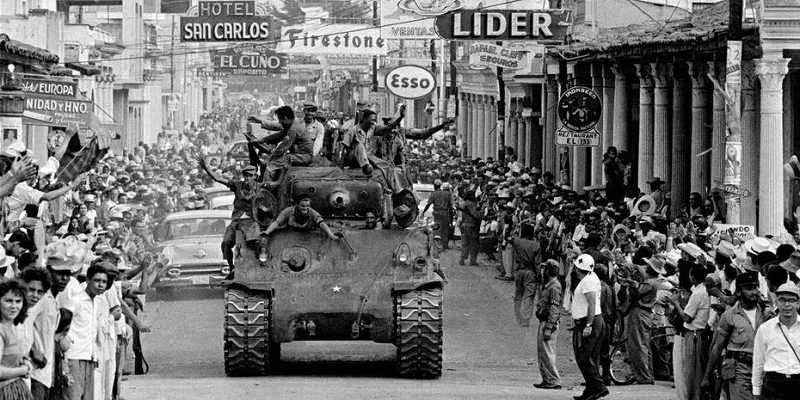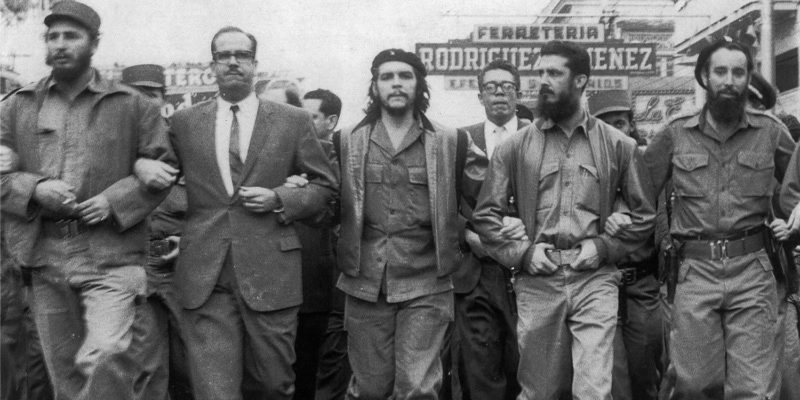We explain what the Cuban Revolution was, the causes of this event and its leaders. Also, what are its characteristics and consequences
What was the Cuban Revolution?
The Cuban Revolution was one of the most important events in the contemporary political history of Latin America and the Caribbean. It consisted of the uprising against the dictatorial regime of Fulgencio Batista in 1953 , by a Cuban leftist guerrilla movement called the July 26 Movement, headed by Fidel Castro .The Cuban Revolution was successful in overthrowing Batista's pro-North American government and establishing a new one under democratic premises. Under the influence of the Soviet Union , he quickly veered toward communism .
It was a Latin American symbol of the anti-imperialist struggle and of the possibility of the self-determination of the peoples. It occurred in a complex and bipolar international context, such as that of the Cold War .
The Cuban Revolution comprises a diverse series of events. It began with the armed struggle with the rebel communist guerrillas , and culminated in the establishment of the revolutionary government . The same was the Cuban dictatorship , ruled almost entirely by the Castro brothers, Fidel and Raúl.
Before the revolution
 The scenario of Cuba in the years before the revolutionary uprising was that of a small and poor nation .
The scenario of Cuba in the years before the revolutionary uprising was that of a small and poor nation .It was a weak republic and an ally of the United States.
It grew up in the shadow of shady liquor stores and casino games , attended by the big American mobsters.
The country was governed by a corrupt democracy , whose management of the State consisted of maintaining order so that an oligarchic elite could enrich itself at the expense of the rest of the people.
The end of this period occurred when popular pressure applauded the candidacy of Carlos Prío Socarrás , of the Authentic party. However, after winning the elections, he was deposed from office by Fulgencio Batista in 1952.
Batista had been a national hero and president of the island . But this time he assumed power through a coup and established a military dictatorship through new fraudulent elections.
Background of the Cuban Revolution
The Batista government failed to hide scandalous levels of corruption or its fraudulent origin . Consequently, a fairly radicalized opposition emerged, of which the attempted takeover of the Moncada Barracks in 1953 is an important example.The young lawyer Fidel Castro led a group of young people from the Cuban People's Party , who called themselves the “Centennial Generation” (due to the birth of José Martí in 1853). They armed themselves and tried to take the mentioned barracks, failing in the attempt.
The failure implied the loss of many of its members , who were imprisoned until 1955. Then they were amnestied by the dictatorship that tried to calm the popular noise and some other attempts of insurrection.
In the tense atmosphere of the Cold War, the world was forced to side with the US (and capitalism ) and the USSR (and socialism ). Latin America suffered from the control of North American anti-communism and in that sense, Batista had the full support of his northern neighbors.
Fidel Castro and his brother Raúl took the opposite side . They went into exile in post-revolutionary Mexico and organized the July 26 Movement (M-26-7) in 1955. It was a group guided by the thought of José Martí, anti-imperialist and focused on the overthrow of the Cuban dictatorship.
Causes of the Cuban Revolution
 The causes of the Revolution can be summarized as:
The causes of the Revolution can be summarized as:
- Popular discontent. The corruption of the Batista regime was unparalleled in the island's history, which translated into the enrichment of an increasingly smaller elite, associated with casinos and the sale of liquor, as well as with North American interests.
- The overthrow of the Cuban People's Party. The militants of the “centennial generation” were from the party that won the 1952 elections and expelled from power by Batista's military coup. This prompted them to take radical actions that would later give rise to the guerrillas.
- The North American intervention in Cuba. The intrusive policies of the US in Cuba dated back decades, since the North American country had intervened in the Cuban emancipation of Spain itself , reserving important quotas of power within its government, directly or indirectly. This engendered anti-American sentiment that pushed certain parties toward communism.
Start of the armed struggle
The armed struggle began when Fidel Castro and his revolutionary troops landed in southern Cuba with his ship Granma, on December 2, 1956. They were received by an army of 80,000 men that quickly wreaked havoc in the revolutionary ranks.Scattered, lost and persecuted, they had to enter the Sierra Maestra mountain . There, just over 20 survivors of the initial 82 reorganized to carry out guerrilla incursions into enemy positions.
The Batista government spread the false news of Fidel's death , hoping to silence the episode and turn the page. However, the “bearded men” (so called because of their appearance) established a clandestine radio station , “rebel radio”. From there they called the people to uprising, slowly adding citizens to their ranks.
The international press echoed the guerrilla movement and soon Fidel and his movement enjoyed the sympathy of the Cuban people.
The conquest of power
 On January 1, 1959, the Revolutionary troops entered Havana , sealing the defeat of Batista. The dictator had fled the island to the United States, as the fall had been predictable for months.
On January 1, 1959, the Revolutionary troops entered Havana , sealing the defeat of Batista. The dictator had fled the island to the United States, as the fall had been predictable for months.Once power was taken, the guerrillas quickly dismantled the Cuban army and assumed itself as the sole national military force. It formed a transitory government with Manuel Urrutia Lleó as President and José Miró Cardona as Prime Minister.
This government contained very different tendencies within it, which they were soon confronted with . The disagreements were expressed especially around the extreme measures undertaken by the revolutionaries, such as the summary trials and executions, the agrarian reform and the undertaking of a communist model.
Communism
In 1960, the visit of Soviet premier Nikita Khrushchev sealed the Cuban government's turn toward communism . At that time the peak of tension in its relations with the US was reached, due to the expropriation of US companies on Cuban soil.That year Fidel visited the UN and delivered a four-hour speech against his enemies in the United States, whom he accused of conspiring to kill him. In 1961, diplomatic relations between the two countries were broken.
In April of the year, the United States financed a mission with the objective of bringing about 1,500 Cuban exiles back to power in Cuba. It became known as the Bay of Pigs Invasion and culminated in a resounding defeat.
This sealed the enmity between the two governments and led to the US embargo on Cuba , which became directly dependent on aid from the Soviet Union. According to voices critical of the regime, Cuba was at that time a communist dictatorship.
Top leaders
 The Revolution was led mainly by the Castro brothers: Fidel and Raúl , as well as their Argentine communist ally, Ernesto “Che” Guevara . Other important members of the struggle were Camilo Cienfuegos and Huber Matos, both Cubans. However, they did not access positions of power once the revolution was won.
The Revolution was led mainly by the Castro brothers: Fidel and Raúl , as well as their Argentine communist ally, Ernesto “Che” Guevara . Other important members of the struggle were Camilo Cienfuegos and Huber Matos, both Cubans. However, they did not access positions of power once the revolution was won.
Why is the Cuban Revolution important?
The Cuban Revolution served as inspiration for other revolutionary movements on different continents . Furthermore, once established in power and founded the socialist state, he collaborated with the revolutionary causes of Africa and America . In some cases it sent armed contingents, as in Angola, Congo and Bolivia .In addition, this revolutionary process established the Cuban communist dictatorship, which still remains intact despite the economic blockade with which the United States has punished it since the middle of the 20th century . From the adherence to or criticism of the Cuban regime, all the intellectuals of the time and later can be divided politically, socially and ideologically.
Consequences of the Cuban Revolution
 The consequences of the Cuban Revolution were:
The consequences of the Cuban Revolution were:
- The end of the Batista dictatorship in 1959 and the proclamation of a new government.
- The gradual transition of Cuba towards a communist government under the command of the guerrillas under Castro.
- The declaration of enmity with the United States and the alliance of Cuba with the Soviet Union.
- Beginning of the US blockade of the island in 1960.
The Cuban "Special Period"
In 1991 the USSR fell as protector of the world's socialist bloc , and thus the Cold War came to an end. This significantly affected Cuba, which was still suffering from the US embargo. It could not trade freely at the same time that its main source of food and financing had just collapsed.This meant an acute period of crisis in Cuba . The population suffered famine, a 36% contraction of GDP , a collapse of transportation due to a lack of hydrocarbons and massive emigration in the most desperate way, thus giving rise to the notorious Cuban “rafters”.
The above content published at Collaborative Research Group is for informational and educational purposes only and has been developed by referring reliable sources and recommendations from technology experts. We do not have any contact with official entities nor do we intend to replace the information that they emit.
Anas is an editor of a prestigious publishing company in the United States. She studied Mathematics in Arizona. Anas is also a teacher and one of her long-term goals is to build an institution that offers free education to everyone who are financially not stable. .
Leave a reply
Your email address will not be published. Required fields are marked *Recent post

Sport: What Is It, Types, Risks, Features, Characteristics and Examples
September 23, 2021

Dogs: Emergence, Features, Characteristics, Feeding and Breeds
September 24, 2021

Story: Definition, Elements, Structure, Features and Characteristics
September 24, 2021

Essay: Definition, Structure, Features, Characteristics, How to Do It
September 24, 2021
